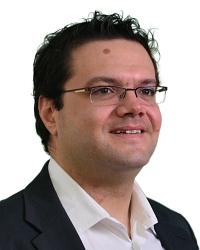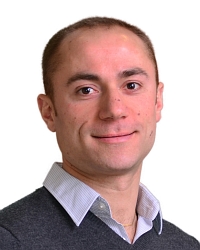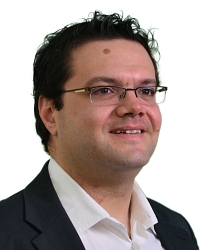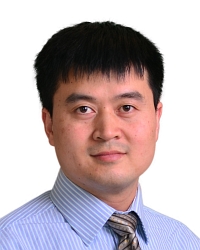TR2018-003
Radar Autofocus Using Sparse Blind Deconvolution
-
- , "Radar Autofocus Using Sparse Blind Deconvolution", IEEE International Conference on Acoustics, Speech, and Signal Processing (ICASSP), DOI: 10.1109/ICASSP.2018.8462402, April 2018, pp. 1623-1627.BibTeX TR2018-003 PDF Video
- @inproceedings{Mansour2018apr,
- author = {Mansour, Hassan and Kamilov, Ulugbek S. and Liu, Dehong and Boufounos, Petros T.},
- title = {{Radar Autofocus Using Sparse Blind Deconvolution}},
- booktitle = {IEEE International Conference on Acoustics, Speech, and Signal Processing (ICASSP)},
- year = 2018,
- pages = {1623--1627},
- month = apr,
- doi = {10.1109/ICASSP.2018.8462402},
- url = {https://www.merl.com/publications/TR2018-003}
- }
- , "Radar Autofocus Using Sparse Blind Deconvolution", IEEE International Conference on Acoustics, Speech, and Signal Processing (ICASSP), DOI: 10.1109/ICASSP.2018.8462402, April 2018, pp. 1623-1627.
-
MERL Contacts:
-
Research Area:
Abstract:
The radar autofocus problem arises in situations where radar measurements are acquired of a scene using antennas that suffer from position ambiguity. Current techniques model the antenna ambiguity as a global phase error affecting the received radar measurement at every antenna. However, the phase error signal model is only valid in the far field regime where the position error can be approximated by a one dimensional shift in the down-range direction. We propose in this paper an alternate formulation where the antenna position error is modeled using a two-dimensional shift operator in the imagedomain. The radar autofocus problem then becomes a multichannel two-dimensional blind deconvolution problem where the static radar image is convolved with a two dimensional shift kernel for each antenna measurement. We develop an alternating minimization framework that leverages the sparsity and piece-wise smoothness of the radar scene, as well as the one-sparse property of the two dimensional shift kernels.
Related News & Events
-
NEWS IEEE-NH ComSig lecture by MERL's Petros Boufounos Date: April 4, 2019
Where: Nashua Public Library, Nashua, NH
MERL Contact: Petros T. Boufounos
Research Areas: Computational Sensing, Signal ProcessingBrief MERL's Petros Boufounos gave a lecture for the IEEE-NH ComSig chapter at the Nashua Public Library as part of the IEEE Signal Processing Society Distinguished Lecturer series.
MERL's Petros Boufounos gave a lecture for the IEEE-NH ComSig chapter at the Nashua Public Library as part of the IEEE Signal Processing Society Distinguished Lecturer series.
Title: "An Inverse Problem Framework for Array Processing Systems."
Abstract: Array-based sensing systems, such as ultrasonic, radar and optical (LIDAR) are becoming increasingly important in a variety of applications, including robotics, autonomous driving, medical imaging, and virtual reality, among others. This has led to continuous improvements in sensing hardware, but also to increasing demand for theory and methods to inform the system design and improve the processing. In this talk we will discuss how recent advances in formulating and solving inverse problems, such as compressed sensing, blind deconvolution, and sparse signal modeling can be applied to significantly reduce the cost and improve the capabilities of array-based and multichannel sensing systems. We show that these systems share a common mathematical framework, which allows us to describe both the acquisition hardware and the scene being acquired. Under this framework we can exploit prior knowledge on the scene, the system, and a variety of errors that might occur, allowing for significant improvements in the reconstruction accuracy. Furthermore, we can consider the design of the system itself in the context of the inverse problem, leading to designs that are more efficient, more accurate, or less expensive, depending on the application. In the talk we will explore applications of this model to LIDAR and depth sensing, radar and distributed radar, and ultrasonic sensing. In the context of these applications, we will describe how different models can lead to improved specifications in ultrasonic systems, robustness to position and timing errors in distributed array systems, and cost reduction and new capabilities in LIDAR systems.
-
NEWS MERL presenting 9 papers at ICASSP 2018 Date: April 15, 2018 - April 20, 2018
Where: Calgary, AB
MERL Contacts: Petros T. Boufounos; Toshiaki Koike-Akino; Jonathan Le Roux; Dehong Liu; Hassan Mansour; Philip V. Orlik; Pu (Perry) Wang
Research Areas: Computational Sensing, Digital Video, Speech & AudioBrief- MERL researchers are presenting 9 papers at the IEEE International Conference on Acoustics, Speech & Signal Processing (ICASSP), which is being held in Calgary from April 15-20, 2018. Topics to be presented include recent advances in speech recognition, audio processing, and computational sensing. MERL is also a sponsor of the conference.
ICASSP is the flagship conference of the IEEE Signal Processing Society, and the world's largest and most comprehensive technical conference focused on the research advances and latest technological development in signal and information processing. The event attracts more than 2000 participants each year.
- MERL researchers are presenting 9 papers at the IEEE International Conference on Acoustics, Speech & Signal Processing (ICASSP), which is being held in Calgary from April 15-20, 2018. Topics to be presented include recent advances in speech recognition, audio processing, and computational sensing. MERL is also a sponsor of the conference.
Related Video
Related Publications
- @article{Mansour2018dec,
- author = {Mansour, Hassan and Liu, Dehong and Kamilov, Ulugbek and Boufounos, Petros T.},
- title = {{Sparse Blind Deconvolution for Distributed Radar Autofocus Imaging}},
- journal = {IEEE Transactions on Computational Imaging},
- year = 2018,
- volume = 4,
- number = 4,
- pages = {537--551},
- month = dec,
- doi = {10.1109/TCI.2018.2875375},
- url = {https://www.merl.com/publications/TR2018-179}
- }


